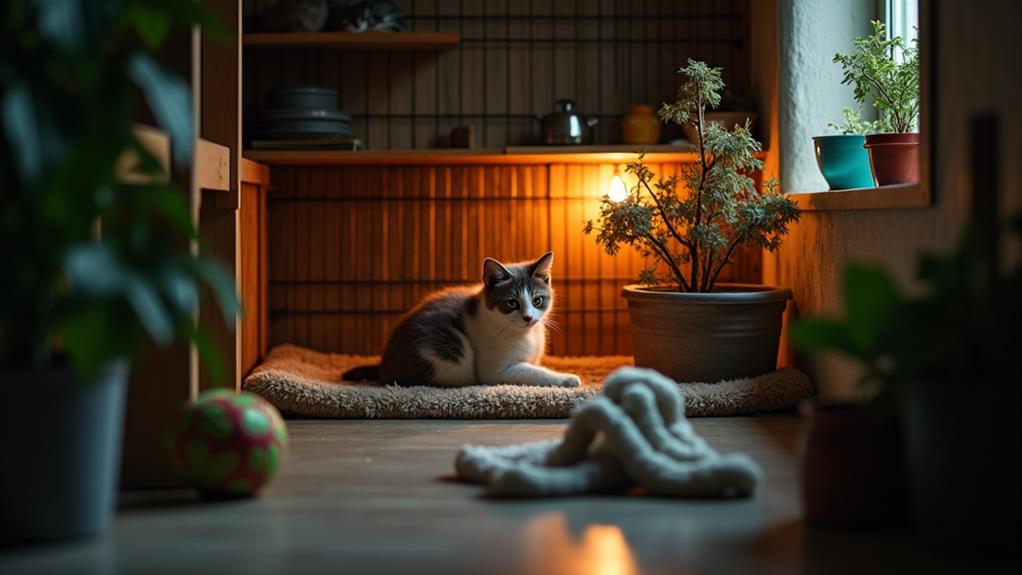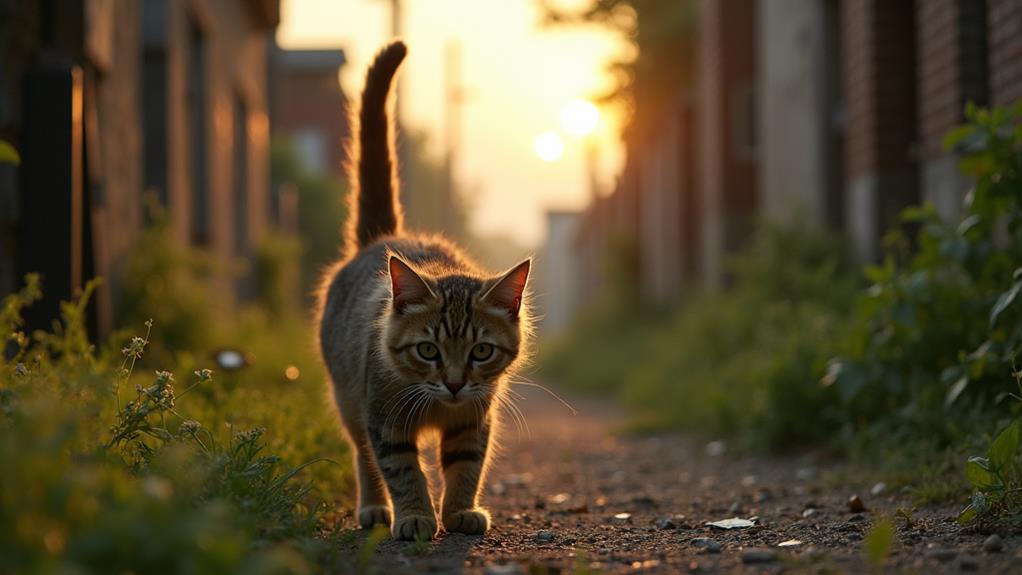How to Break a Feral Cat: Gentle Steps for Transitioning to Domestication

To domesticate a feral cat, begin by creating a safe, quiet room with necessities like food and a litter box, allowing the cat to investigate on her own terms. Spend time in her space to build trust, letting curiosity lead her to you. Use treats and gentle vocalizations to create positive associations. Maintain a consistent routine and observe her body language to gauge comfort. Encourage interaction gradually, allowing her to initiate contact while respecting her space and pace. Implement calming techniques like slow blinking and soft movements. With patience and understanding, you'll start seeing signs of a blossoming relationship.
Understanding Feral Cat Behavior
Feral cats are unique creatures, and understanding their behavior is crucial if you're looking to interact with or help them. These cats often steer clear of humans due to their instinctual nature and upbringing. They might hiss, bite, or display other defensive behaviors when threatened. However, their body language can offer you critical insights into their emotions. A cat's ears pinned back might signal fear, while a tail held high can indicate curiosity or confidence.
Semi-feral cats, those with some previous human interaction, may exhibit different behaviors compared to multi-generation unsocialized cats. The former might show signs of abandonment issues, while the latter typically express a deep-rooted fear of humans. Understanding feral cat behavior involves recognizing these nuances and responding appropriately.
Furthermore, their social structures within colonies can influence individual behaviors. Cats often form groups based on resource availability, and these social dynamics can affect how each cat reacts to human presence. Gradual exposure to humans and consistent positive experiences can help feral cats grow more comfortable. By interpreting their body language and understanding their fears, you can better assist in converting them from feral to semi-feral, and eventually, more domesticated companions.
Creating a Safe Environment
To help a feral cat feel safe, start by creating a secure environment tailored to its needs. Designate a quiet room as the cat's sanctuary. Equip it with necessities like food, water, a litter box, scratching posts, and toys to create a comfortable space for your semi-feral cat's acclimatization. Position the food and litter box on opposite sides of the room. This encourages exploration and allows the cat to feel safe while eating.
Incorporate multiple hide spots, such as cat houses or draped blankets. These hiding places offer your semi-feral cat options for retreat, helping to alleviate stress. Confirm the environment is free from harmful or fragile items to prevent accidents and make the cat feel safe in its new surroundings. Spend time in this designated secure space daily. Your presence helps the cat associate you with safety and comfort, fostering trust over time.
Here's a checklist for setting up the room:
- Quiet Sanctuary: Designate a room that's calm and away from household noise.
- Opposite Placement: Position food and litter box on opposite sides.
- Hide Spots: Provide multiple hiding options.
- Safety Check: Remove harmful or fragile items.
Let the Cat Approach

Once you've established a secure environment for your semi-feral cat, the next step is allowing her to approach you on her own terms. Encourage her curiosity by remaining still and ignoring her. This approach can spark interest and motivate her to come closer willingly. It's vital to let the cat make the initial move, as this helps her feel safe and in control of the situation.
To help her feel at ease, create a relaxed environment. Associate your presence with positive experiences, like mealtime, which can foster a sense of safety and trust. Remember to avoid direct eye contact, as this can be perceived as a threat. Instead, make eye contact briefly and softly, then look away.
Your body language plays a significant role in making her feel secure. Approach her in an arc with a soft posture, which reduces the perceived threat. Introduce treats or toys gradually, but only engage when she shows interest. This reinforces her initiative, letting the cat know she's in charge of the interaction.
Patience is key. Building trust may take weeks or longer, depending on her background. Gradual engagement is fundamental for success.
Building Trust With Food
Establishing a regular feeding schedule is fundamental in building trust with a feral cat. By doing so, you create a sense of security and predictability, which is vital for gaining her trust. Consistency in feeding times helps the cat understand that food will always be available, reducing anxiety and making her more open to your presence. Use high-value treats like Gerber meat baby food or dried liver to encourage her to approach. These treats promote positive associations with human presence.
Sit quietly in the room while she eats, allowing her to feel safe and relaxed. Your calm demeanor will help reduce stress or fear during feeding times. Gradually move the food closer to you during each session. This helps the cat become comfortable with your presence and encourages exploration without feeling threatened. Consider incorporating hand feeding to further reinforce trust. Offering food directly from your fingers can help the cat associate human touch with positive experiences.
Key steps to build trust with food include:
- Establish a consistent feeding schedule.
- Use high-value treats for encouragement.
- Sit quietly nearby during feeding.
- Gradually move food closer to your position.
Gradual Human Interaction

A key aspect of shifting a feral cat towards domestication is allowing her to initiate contact at her own pace. Start by offering food on your fingers or special treats to create positive associations with human interaction. This encourages the cat to approach you without feeling threatened. Remember, patience is essential. Let her come to you when she's ready, using food as a gentle coaxing tool.
Extend a closed fist slowly towards her as an invitation for interaction. This non-threatening gesture makes her feel safe and more inclined to investigate. Be sure to avoid direct eye contact, which can seem intimidating to a feral cat. Instead, keep your gaze soft and indirect, helping her feel more comfortable in your presence.
As she becomes more familiar with you, practice gentle and slow movements. Never force physical contact; semi-feral cats may need extra time to lower their guard. Your goal is to foster trust, not fear. By respecting her space and allowing her to dictate the pace of interaction, you're laying the groundwork for a successful shift to domestication. Over time, these small, gradual steps help her feel secure and open to human companionship.
Recognizing Body Language
How do you know what a feral cat is feeling? Observing its body language is key. Understanding these visual cues helps you determine if a cat is feeling comfortable or threatened. For instance, a tucked tail signals fear, while an upright tail shows confidence. Forward-facing ears mean the cat is curious or interested, whereas flattened ears can indicate fear or aggression.
You'll often notice a cat's tail position shifting as it interacts with human voices or new environments. A puffed-up tail usually indicates fear or defensiveness, while a gently swaying tail can mean the cat is excited or playful. When a cat feels safe, you might see it lying on its side or back, showing that it's comfortable in its surroundings.
Here are some significant body language signals to watch for:
- Slow blinking: This indicates trust and affection. If you reciprocate, it can help strengthen your bond.
- Relaxed posture: A cat lying on its side or back shows comfort and safety.
- Ear position: Forward-facing ears suggest curiosity; flattened ears mean fear or aggression.
- Tail position: An upright tail shows confidence; a puffed-up tail indicates fear.
Respecting Personal Space

Understanding a feral cat's body language is just one piece of the puzzle; respecting its personal space is likewise significant. Providing hiding places is vital for a feral cat's comfort. These spots offer a sense of security and an escape route when they feel overwhelmed. Confine the cat to a small room with necessities like food, water, and a litter box to prevent sensory overload. This environment lets them investigate and retreat as needed.
Respecting space is important. Forcing interaction can trigger a fight or flight response, leading to stress or aggression. Monitor their body language closely. Signs like flattened ears or a tucked tail mean they need more distance. Spend time in their space daily, but confirm your presence is non-threatening. Sit quietly, allowing them to observe you at their own pace. Your calm demeanor helps them adjust to having you around.
Use soft human voices when you're in the room. Speaking gently can soothe the cat and make your presence less intimidating. Over time, this approach builds trust and helps the cat become more comfortable with human interaction, aiding their shift to domestication.
Implementing Calming Techniques
Implementing calming techniques is crucial when working with feral cats. Start with slow, gentle movements to reduce the perception of threat, making the cat feel more comfortable in your presence. Use soft vocalizations during feeding times to create a calming atmosphere. These soothing sounds help the cat grow accustomed to human voices without feeling threatened. Remember, direct eye contact can be intimidating, so use slow blinking as a non-threatening way to communicate safety and affection.
To further ease anxiety, introduce calming remedies like pheromone sprays or catnip. These tools can make a significant difference in helping the cat feel more secure in its new environment. Establishing a routine with consistent feeding and interaction times will also help reduce stress. Predictability is comforting and can accelerate the cat's adjustment to its new surroundings.
Here's a quick checklist to guide you:
- Use slow, gentle movements: Mimic calming practices to reduce perceived threats.
- Employ soft vocalizations: Create a soothing environment during feeding.
- Avoid direct eye contact: Use slow blinking to communicate safety.
- Introduce calming remedies: Utilize pheromone sprays or catnip for added comfort.
Monitoring Progress and Setbacks
As you establish calming techniques with a feral cat, it's crucial to keep an eye on both progress and setbacks in their socialization adventure. Monitoring progress involves observing the semi-feral kitty for signs of comfort, like blinking eyes, ears positioned forward, and a relaxed body posture. These behaviors indicate growing trust towards you. However, be prepared for sudden regressions, especially after significant changes, such as moving from a crate to a room. These setbacks are a normal part of the process and require patience.
To support your semi-feral kitty during these challenging moments, reinforce positive experiences by hand feeding them. This technique helps the cat associate your presence with safety and nourishment. Always aim to conclude interactions on a positive note, using gentle play or offering treats. This approach encourages future engagement and gradually builds the cat's confidence over time.
Document each milestone and setback diligently. This practice will give you insights into the cat's behavioral changes and help you track general progress. By understanding these patterns, you can adjust your approach to better support the cat's progression from feral to a more domesticated life.
Celebrating Successes and Milestones
Recognizing even the smallest victories in taming a feral cat is essential in their path towards trust and companionship. Celebrating successes, such as the cat approaching you for food or showing signs of comfort, reinforces positive behavior and encourages further progress. Each milestone, like the initial time your cat purrs or lies on its side, should be documented. This allows you to track changes and celebrate achievements, fostering a sense of accomplishment not only for the cat but also for you.
Sharing these success stories with communities focused on feral cat care can be incredibly motivating. It inspires others to continue their efforts and highlights your expedition's milestones. When your cat initiates contact or displays trust, providing extra treats or special rewards strengthens the bond between you and improves their sense of safety.
Recognizing and rewarding positive behavior such as:
- Approaching for food
- Initiating contact
- Showing relaxed body language
- Initial purring experience
These signs of trust, like blinking slowly at you or exhibiting relaxed body language, solidify your relationship. Over time, these consistent celebrations of successes and milestones encourage further interaction, paving the way for a harmonious companionship.




